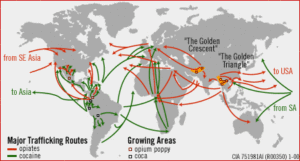Dwight John Zimmerman has authored Area 51 in collaboration with artist Greg Scott, to tell the location of this key aeronautical research location in Groom Lake, Nevada. Of course, Area 51 is a favorite of UFO buffs and conspiracy theorists, and both these topics are covered (p. 3-8, 15, 51). These ideas, however, are not the core of this work of graphic non-fiction. Instead, this is a sweeping historical study, which describes the successes and failures that the U.S. intelligence and military services experienced while developing new aviation technologies at Area 51.
What is impressive is the quantity of material that Zimmerman is able to cover in 91 pages. Greg Scott’s realistic style works well with this content. Many of the black and white sketches remind one of period photographs. Scott is equally adept at capturing the look of advanced aircraft or a battle field. The text and images meld well together.
What most interested me about the work, however, was its extensive discussion of drones, particularly their early history (p. 42-50). Today global powers are discussing creating drone submarines, and even drone submarine hunters. In Northwest Pakistan and Yemen the United States has been carrying out an undeclared war. With a recent drone strike in Libya, the scale of the conflict seems to be expanding. This technology has developed with amazing speed.
As Zimmerman discusses, the United States invested vast amounts of time, funds and expertise into drone development in the early 1960s. For example, in 1964 the United States used drones to carry out “160 reconnaissance missions over China” (p. 44). Remarkably, in 1962 the United States began work on a Mach 3 drone, which proved unsuccessful (45). The scale of American investments is fascinating, but in the end Zimmerman argues that the U.S. failed, because the key technology to enable drones to work had not yet been developed.
By the 1980s, the situation had changed. Zimmerman describes (p. 65-73) how the rapid increase in microprocessor speeds permitted the U.S. air force to create a new generation of drones. The first drone was used in a combat theater in 1999 during the conflict over Kosovo. Scott’s images (p. 73) capture the rapid evolution in drones’ capabilities, from being tasked with aerial reconnaissance, to being used to accurately deliver laser guided bombs upon particular individuals. As Zimmerman makes clear, the U.S. is currently developing a host of new drones, which even include helicopters (p. 88).
In an earlier blog post I reviewed the book Ghost Fleet, which described a hypothetical future conflict between the United States and China, in which drones played a central and horrifying role. The groundwork for these robotic conflicts is being laid now. While cyberwarfare -such as the Stuxnet attack on Iran’s nuclear program- has attracted the attention of security theorists, I believe that drones merit equal attention or more. Few people are regularly being killed in cyber warfare, but this is not the case with drones. While the United States took an early and impressive lead, other countries are now rapidly developing these technologies, particularly in Asia. The area of the world that is now seeing the most sustained and significant growth in military spending is Asia, and these expenditures are largely being driven by the issue of the South China sea. If one were to see the emergence of a major conflict in which drones played a central role, this would certainly be the most likely location. If so, doubtless some of the drones involved will have been designed in Area 51.
Scott and Zimmerman’s book is well-written, beautifully illustrated, and compelling. Highly recommended for anyone interested in military technology and Area 51. The truth is out there.
Do you want to read about a true historical mystery? Please read my post about the ghost ship the Baltimore, and the mystery woman who was found aboard after the entire crew disappeared.
Shawn Smallman, 2016


